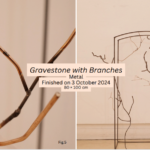Core Concept & Curatorial Background
Eclipsing Presence explores the paradox of death—not as an absence, but as a transformation, a lingering presence that reshapes memory, space, and perception. The exhibition examines how different cultures visualize and ritualize death through color, ephemeral materials, and immersive experiences. Inspired by contemporary curatorial discussions on collaboration, self-expression, and liminal spaces, the exhibition is envisioned as a dynamic space that challenges traditional mourning aesthetics and curatorial narratives.
In Chinese culture, death is not an end but part of the natural cycle of life. For example, in Daoist philosophy, Zhuangzi responded to his wife’s passing by singing and drumming on a bowl, embracing the transient nature of life. Similarly, the poet Tao Yuanming wrote, “Drifting along with the great transformation, neither joyous nor afraid,” reflecting a detached perspective on mortality. These philosophical perspectives form the foundation of the exhibition’s thematic exploration.
Simultaneously, Western existentialist philosophy, as explored by Jean-Paul Sartre and Simone de Beauvoir, provides an alternative framework. Existentialist thought suggests that individuals must construct meaning in the face of mortality’s absurdity. This exhibition seeks to bridge the serenity of Eastern philosophy with the individualistic struggle of existentialism, prompting audiences to reconsider their own perspectives on death through artistic engagement.
Curatorial Overview
Venue & Spatial Design
- Primary Venue: A historical building, temple, cemetery, or outdoor site where the space itself carries the imprint of time, allowing audiences to experience death as an evolving state rather than a fixed end.
- Alternative Option: A hybrid format, incorporating both a physical exhibition and an interactive digital archive, enabling global participation in reflections on mortality.
The spatial design draws from Eastern aesthetics, particularly the concept of negative space (留白, liú bái), where emptiness is as meaningful as presence. Through shifts in light, shadow, and color, the exhibition invites contemplation on impermanence.
Exhibition Format & Key Features
- Time-Based Installations: Works crafted from wax, flowers, paper, and other transient materials, gradually decaying or transforming, symbolizing impermanence.
- Interactive Engagement: A “memory wall” where visitors can inscribe messages to the deceased, which fade over time, mirroring the ephemeral nature of remembrance.
- Multi-Sensory Experience: Utilizing soundscapes, fragrances, and temperature shifts to evoke an immersive encounter with death beyond the visual.
- Cultural Dialogue: The exhibition contrasts white as the color of mourning in Chinese culture with black in Western traditions, inviting reflection on how color codes influence grief and memorialization.
Exhibition Objectives
- Deconstructing Death Narratives: Encouraging audiences to move beyond fear and reframe mortality as transformation.
- Fostering Cross-Cultural Dialogue: Highlighting diverse representations of death, bridging philosophical and artistic traditions.
- Challenging Curatorial Approaches: Implementing unconventional curatorial strategies to provoke deeper existential engagement.
Key Themes & Highlights
- The Chromatic Symbolism of Death
- White vs. Black: In China, white symbolizes mourning, while in the West, black holds this role. The exhibition explores these associations and their cultural underpinnings.
- The Dual Nature of Yellow: Yellow is revered in imperial traditions but also associated with decay and sickness. The exhibition examines its shifting significance in death-related iconography.
- Existentialism & Mortality
- Sartre & Camus: The exhibition examines how existentialist thinkers like Sartre and Camus grappled with the absurdity of death and the quest for meaning.
- Existentialist Art: Showcasing works influenced by existential thought, such as Felix Gonzalez-Torres’ light installations, which emphasize life’s fleeting nature.
- Eastern Philosophical Narratives
- Zhuangzi’s Drumming on the Bowl: Recreated through an installation, embodying a Daoist perspective on accepting life’s transience.
- Tao Yuanming’s Poetry on Death: A visual-textual exploration of Tao’s reflections on mortality, set against shifting light projections.
Critical Questions
- How can curatorial practices capture the multifaceted nature of death?
- How can exhibitions represent mortality in ways that honor both personal and cultural perspectives?
- How does color shape our perception of death?
- What role do aesthetic codes play in shaping rituals, emotions, and philosophies surrounding mortality?
- How does existentialist thought deepen our understanding of death?
- In light of Sartre’s notion of absurdity, how can death serve as a means of constructing selfhood?
- How does audience participation enrich curatorial interpretations of death?
- How can interactive elements transform exhibitions from static displays into spaces of collective reflection?
Conclusion
Eclipsing Presence is not about the finality of death but about reimagining life through the lens of impermanence. By integrating Eastern philosophical detachment, existentialist agency, and cross-cultural artistic interpretations, the exhibition aims to guide audiences toward new ways of confronting mortality. Death is not simply an absence; it is a shifting presence—one that demands reevaluation, artistic exploration, and personal contemplation.




